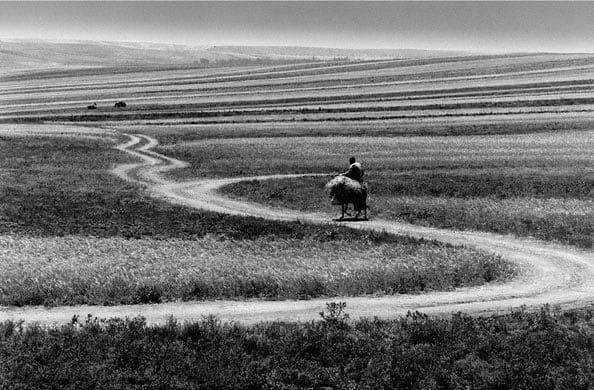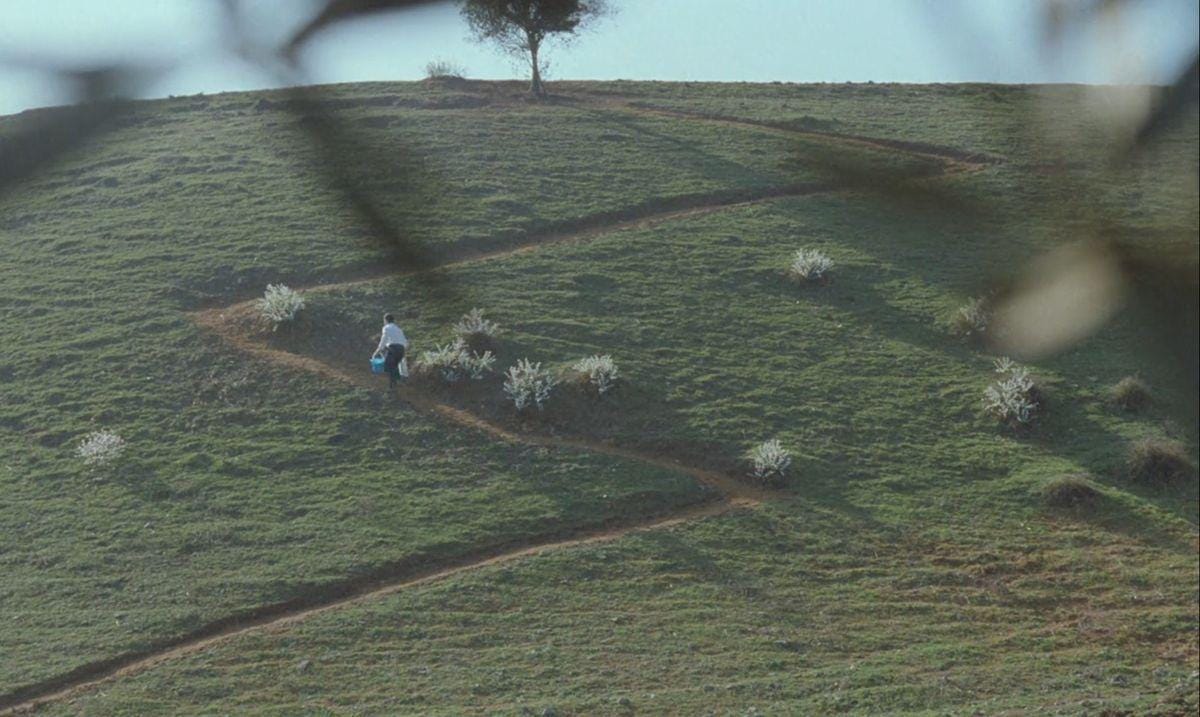On the Road with Kiarostami
A short essay on the element of the road in Abbas Kiarostami's filmography
Back home, Asghar Mamu never let us touch his car. “The road,” he said, “ages everything that passes on it.” I couldn’t quite grasp his meaning. Did he think taking his vehicle would age it faster? I don’t know. He died this morning, and now we were driving to his city, watching our car grow weary with every turn of the wheel. Along the road, the streetlamps flickered in the night. Limp sunlight slipped past the windows to gleam on the contours of my cousin’s cheek. Mamu had loved him most, I thought. I had no time to think of myself.
Outside, the highway to the city hummed like a lyre, whining with each speeding car. All those times I’d traveled, I memorized the sprawl of prairies and husk fields along the roadside, ignoring the steers and the speed. I remember that street. It stretched before us, dipping into occasional slopes with no end in sight. The patched pavement, the outlining fences, the maple leaves, gas stations, the bend of light, the white lines—all these, framed by a timeless view, drew me closer to having experienced a fanatic tussle of beauty.
Like Kiarostami, I trace my fascination with roads, paths, and lanes back to childhood. As a child, I saw the world in two ways: once, as it was and the other as a metaphor. I recall a summer in my village, carving an autumn-dressed track from the main path, carefully scooping it from the busy, rustic sand street into a patch of balding earth. “Desire Trails,” they called them on Reddit back then. These were paths formed over time simply by walking. The desire trail I carved in a barren field of my village has since become an alley. It taught me this: if you tread a path enough to scar it, someone will always follow.

Weeks after Mamu’s funeral, I found Roads of Kiarostami, a short documentary by the legendary auteur Abbas Kiarostami. It was a piece of art that immortalized those moments on the road for me. I’d watched his films before, so I knew the filial relation it has with being a human, but Roads of Kiarostami for me, was a trajectory into the mystical womb of his perception. It comprises hundreds of roads, paths, and tracks photographed by Kiarostami over twenty-five years. It is a chowk of photography, poetry, and music that slows down life to let you observe. It’s a revelation of the self, that will turn you insipid about recognizing paths as only physical spaces. In the documentary, Abbas recites,
“The road is the expression of man’s journey in search of provision. The road is an illustration of the soul without peace, and the body is the pack animal of the soul that carries it from place to place. Whoever neglects his pack animal will never reach the journey’s end, but the journey of man continues. Our roads are like ourselves, sometimes stony, sometimes paved, sometimes winding, sometimes straight and the paths we draw on earth are like scratches upon it. And we have other ways inside us, ways of sadness, ways of joy, ways of lone, ways of thought, ways of escape, and sometimes ways which spring from hatred, ways which destroy us, ways which go nowhere, ways without conclusion, like a stagnant river. The road is a man’s confession of places he is fleeing from, the places he is heading. The road is life, the road is man, and man’s road however small, flows on the page of existence, sometimes without conclusion, sometimes without defeat.”
Roads lead us to salvation, to doom, to satisfaction, to enmity, to love, to ourselves. Any true definition of a road must transcend its physical form or location. It was on a road that Siddhartha saw an old man, then a sick man, then a lifeless body, and annihilated the “being” to become Gautama Buddha. When Kiarostami says, “The road is the expression of man’s journey in search of provision,” he suggests that everyone is a road, each moving to the same place in different ways—a marsh, a forest lane, an alley, a maze drawn on paper, a season, a mirror, a street, a skin. We keep inventing our turns and ways on the road, but we never stop. Every path in the world connects, a divine response to our needs. All our lives, we walk a path that converges more and more. It’s a metaphor for human desires, for the “being” that fades and the “becoming” that endures. In a slow burn too swift to track, his voice insists that the road’s journey is the self’s journey, even if the only way we know is the way back. In the documentary’s roads, we never reach a destination; we coil deeper into Abbas’s paths.
What Kiarostami narrates here is something timeless, something far more archaic than what we can perceive. In Sufi traditions, it suffices that you just walk and walk until the road makes sense until you become the road. The toughest roads, they say, are roads to the self, one that requires self purification (Tazkiya al Nafs) along the way. That’s why dervishes are travelers, not settlers; the road is their baptism. To be a faqir or a flâneur isn’t just to stroll—it’s a journey within. Perhaps that’s why John Earle, an Oxford professor of Anglo-Saxon, originated the word “road” from “rod,” meaning “clearing.” Like ridding our homes of vermin or junk, he assembles the root of a road, etymologically, to be a way to sanctify ourselves. My linguist friend disagrees: “That’s completely wrong—‘road’ comes from ‘rād,’ meaning horseback. It’s a space for riding a carriage, the early people very clearly distinguished between a footpath and a road.” The road is an illustration of the soul without peace, and the body is the pack animal of the soul that carries it from place to place. Wherever we walk, it becomes a lane. The trip to our beds is a road; a face leaning for a kiss moves through one. Our body is a vehicle for the hidden parts of our existence on these tracks. And what is a road, if not a space where we drive our carriage—our body—forward?
Outside, the once-streamlined view had twisted into a misaligned cog amid a million loosened machines. The traffic jam stretched endlessly, vehicles lined up with no clearance. We should have taken another route, like Frodo and Sam, who chose back roads to Mordor in The Lord of the Rings for a better chance of survival, I thought. Inside, we had wept alarmingly less, but the grief absent from our eyes now transformed into a complete human sitting with us in the back seat of the car, watching.
On these cars, on these roads—so much of our lives is spent. On these paths, we seek freedom. The car’s interior feels like a Catholic chapel. A friend says it’s the front seats’ design, the way they unlock your gaze, letting you wail freely without fear of confrontation. In Kiarostami’s world, a car on its way somewhere is both haven and confessional. He says, “The car is… one of the few spaces in the Islamic Republic of Iran where women (while still, admittedly, with their heads covered) are free to express themselves without fear of recrimination. Where else, for example, could a mother tell her ten-year-old son that she branded his father a drug addict to secure her divorce because ‘the laws of this country give no rights to women’?”
Kiarostami says, “Our roads are like ourselves, sometimes stony, sometimes paved, sometimes winding, sometimes straight, and the paths we draw on earth are like scratches upon it.” Roads tie his films together. Nearly every one features winding roads—paths that give you time to reflect without straying far, roads that reveal glory and ruin from every angle, roads hinting at something he couldn’t quite grasp. He travels a road without end, by choice. No shortcuts exist here. These are paths to truth, rarely trodden. Edward Thomas captures it in his poem: “While we forget, and are / Forgotten like a star / That shoots and is gone… / The next turn may reveal / Heaven: upon the crest / The close pine clump, at rest / And black, may Hell conceal.”
In Kiarostami’s Koker Trilogy, filmed in the village of Koker in Northern Iran after a devastating earthquake, the town’s paths unite. The disaster weaves all stories into facets of one life. In all three films—Where Is My Friend’s House, Life and Nothing More, Through the Olive Trees—the village becomes a canvas, cut off from the world. Cars circle endlessly; children dart through alleys, always returning home to rest. A zig-zag path etched on a hill recurs. Ahmad from Where Is My Friend’s House climbs it again and again, never breaking the pattern or forging a desire trail. A director in Life and Nothing More pants uphill, seeking Ahmad. Hossein in Through the Olive Trees chases Taherah along that same worn path, yearning for her answer. Our roads are like ourselves. That track is all these characters at once—indecisive, exhausting, defiantly nonlinear, shaping the geometry of existence.
Likewise, in Kiarostami’s acclaimed Taste of Cherry, a young man drives winding, dusty roads outside Tehran, seeking someone to bury him after his suicide. In Close-Up, the film ends on a road where Hossein Sabzian, who impersonated director Mohsen Makhmalbaf, sits beside him, discussing life. Kiarostami’s roads turn his works into parables. Hossein, striving to embody the celebrated Makhmalbaf, shrinks on his motorcycle. These roads are more than places; they’re harmoniums of choice and uncertainty.
Call it remorseful, but the roads are endless—and we are finite. Slavoj Žižek puts it this way: the light at the end of the tunnel is just another train. Paths never end, even when they seem to. In Van Gogh’s Wheatfield with Crows, the road is loud, forked, and decayed—an urge to escape spills from its edges. In Tom and Jerry, roads are lavish and empty—a dreamscape of wide, straight paths with no strangers, no blockades, where clocks stop and illusions linger, an anarchist’s paradise. It stirs our longing to know our destination, infuriating Kiarostami, whose paths always intertwine. That’s why, in Abrahamic faiths, Ihdinas-Siratal Mustaqeem—“guide us to the straight path”—is a vital prayer. Kiarostami lets us peek into folklore and myths where the symbolic weight of roads is overlooked. All roads lead to one end; only the maps differ.
Just like the migratory birds about whom W.H. Hudson says, they feel something akin to pain and fear just before migration. Perhaps just like the birds, nothing could alleviate this feeling except flight, where they beat their wings until they reach their place.
The traffic didn’t clear on the highway. “The road, however small, flows on the page of existence, sometimes without conclusion.” And there we were, sandwiched between two Toyotas, listening to Bob Marley for the fourth time in a row. Asghar Mamu had died. My cousin hadn’t spoken since the news. It infuriated me—why couldn’t he cry when his voice rattled like a bag of bolts?
Outside, the calm was escaping its colors. Beyond the windshield, migratory birds were returning. When the traffic opened, we were the only people left on the street. Our feathers gliding in the air, slouching towards the backseat.
───── ⋆⋅☆⋅⋆ ─────











me vs wanting to restack every sentence you write
What a beautifully written and moving piece. Love Kiarostami and love this!